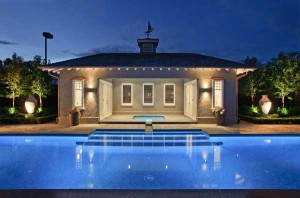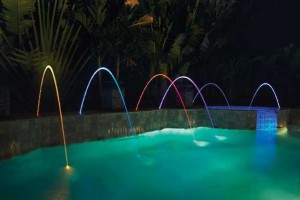Underwater lighting transforms evening poolscapes


In the evening, pool water can either be an inky blackness or can glow invitingly as light ripples across the surface.
Underwater lighting used to be generated by unsightly domes that sometimes required the pool drained to be safely changed. Now lighting technology and designers have combined to create stunning effects that shine seamlessly from the wall.
“It wakes up the pool at night,” says Jules Harwood of Spa Electrics. “Without lights, the pool is a black hole instead of a feature in your garden.”
Underwater lighting comes down to effects and energy efficiency. According to Harwood, there are two main styles of lights: a surface mounted light that protrudes from the pool wall; or a flush mounted light – commonly known as a niche – that is installed on the side of the pool wall, exposing only the face plate of the light. “It sits flush against the wall and only minimally protrudes,” Harwood says. Both can be installed in concrete, fibreglass or vinyl lined pools. Flush lights are preferred for their smooth and contemporary style.
Effects
Landscape architect Marian Spiller from Peter Glass and Associates believes that lights contribute much more than simply illumination.
“You can achieve amazing effects and ambience,” Spiller says. “It’s limitless.”
She explains that lights can be arranged in different beam spreads to achieve an overall glow – or specifically aimed at one point. The effect can be subtle or bright, depending on what’s required.
“It depends on the design of the pool and harmony with the landscape,” she says. “Lights can also be used to highlight features walls, fountains or cascades.”
David Berryman of Signature Showcase Pools suggests that the effects of underwater lights are underestimated. As well as the decorative element of lighting the pool, it continues the feeling of the “outdoor room” at night, accentuating the overall perception of space.
“In Queensland, the outdoor room is the ultimate goal,” he says. “There’s only a couple months of the year where you don’t go outside. People come home from work late and they can still enjoy the pool and see it.”
Berryman is seeing demand for pond style lights – sometimes placed at the bottom of the pool but usually on the wall – that change the colour of the pool rather than its simple reflection. Some lights have multi-coloured functions that can periodically change the colour of the water across the spectrum.
Spa Electrics offers the multicoloured light LED in ten different programs, ranging from warm and cool whites to bright colours like magenta, as well as gaining a rainbow effect from a blend of multicoloured programs that can either be set on fast or slow blends.
Berryman is often asked to create a specific atmosphere, such as the seaside lights that mimic the ocean hues. He says these are about $350 to $600 per light.
Berryman is also interested in marine grade LED lights, which he says are especially suitable for pools with depth. “They’re stronger and brighter. Clients really like the landing strip effect.”

Demand for different lighting effects varies depending on the location. “In Sydney it’s more subtle than Queensland,” says John Storch of A Total Concept Pools, Sydney. “And in Melbourne it’s even more subtle.”
“In Melbourne particularly the pool has to be pleasant to look at, as it is a short swimming season,” comments Nathan Kinder of Aloha Pools.
The number of lights used, tile colour, pool finish, light positioning and water clarity can all affect light colour and intensity.
“You really can’t talk about light without talking about colour,” says Kinder. “In a green swimming pool with a gold tile, this base will impact on the eventual light thrown from the pool by the lights.
“It’s like stage lighting in a sense,” he says. “It depends on the colour of the swimming pool itself. What colour is a red apple in a black room? The answer is not red. There’s no light to reflect the red.
“Most people go for a mid -blue to blue light. There’s a funny science in it. We ask the question about what sort of tiles before we think about lights – a dark lagoon pool would need ramping up the lighting with five or six lights. Alternatively with a white tile in the pool, we’ll put fewer lights in as you have the reflection.”
Position, spas and safety
“In terms of lighting location, we would want to ensure you didn’t get spotting,” says Kinder. “Nobody wants to sit at a barbecue, entertaining their friends and have to put a hand over their eyes because they’re getting dazzled.
“If you’re sitting in the lounge room, you want to see a lit pool – you don’t want to see the light. We hide them in the wall of the pool closest to the living room, so the light is shining away from the house.”
Berryman agrees. “It’s all about illuminating the pool so it looks nice and lush, rather than a black spot and bright lights. It’s about ultimate illumination, rather than patches,” he says.
Spas also need lighting
“Spa lights are specifically made for spas,” says Ken Pickford of Sapphire Spas, who has the My Spa Effects Liquid & Light designed to interact with the movement of the water.
“On a spa, you put between ten and fifty little lights, so you light the perimeter of the spa and the controls. With the liquid light they are waterfalls like in a casino but shoot above water,” Pickford says.
An evening swim is refreshing after work. A well-lit pool illuminates the water to allow adults to properly supervise children using the pool after dark and also to add to the enjoyment of the evening experience.”
“Many of us do not have time to swim during daylight hours,” says Jules Harwood. “Installing underwater pool lighting allows you to swim safely and enjoy your recreation time in the pool at night.”
Lights also contribute towards overall safety both within the pool and by enhancing surrounding landscaping lighting.
“It’s important to light around the stair area,” Marion Spiller says, as another safety consideration.
“You need external lighting too,” Berryman says. “It adds to the atmosphere. For example, deck lights create a boardwalk for a beach theme – but they also add to safety. You don’t want kids running around in the dark when there’s a crystal clear fence.”




